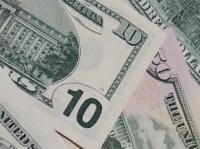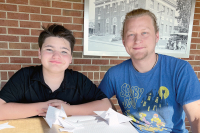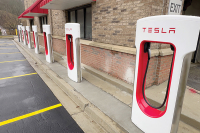Sales tax shuffle
What the bill says: The method of doling out sales tax to towns and counties would be changed to give more to rural counties and less to towns and cities than under the current formula.
Duly noted: Two cents of the state sales tax currently goes to towns and counties. Of that, 1.5 cents is given out according to where the purchase was made and remaining half cent is according to population.
More sales tax goes back to wherever the sales are being made, so the more stores and more shopping a town has, the more sales tax it gets. The same is true for tourist towns that get back a portion of the sales tax tourists paid while shopping in their community.
“Currently, the more economic activity there is in a place, the bigger share they get,” explained Scott Mooneyham with the N.C. League of Municipalities.
Meanwhile, rural counties with fewer stores don’t fare as well under the current formula, because people who live there leave the county to shop, and in the process give their sales tax to a nearby urban area.
The proposed bill would change the formula.
Related Items
Sales tax would be doled out to towns and counties based wholly on their population — it would go into one big pot and be divided based on the size of the community only, not where the spending was done.
Why be for it: Rural counties don’t get their fair share of sales tax currently, simply because they don’t have the same concentration of stores. When someone from Swain County drives to Walmart in Sylva to buy a TV, Swain loses out on the sales tax, even though the person doing the buying and paying the sales tax is from Swain.
“The municipalities are getting richer and the poor counties are getting poorer,” said Sen. Jim Davis, R-Franklin.
When rural people leave their own county and spend sales tax in urban centers, it’s not fair for the urban center to lay claim to a disproportional share of that sales tax. Davis said the county where that rural person lives should get more back.
“It is the fair thing to do so every body benefits from the success of the state,” Davis said.
Swain County Manager Kevin King said Swain stands to gain $1 million under the proposal to dole out sales tax based on population alone.
While Swain sees lots of tourism spending —and currently gets back a portion of the sales tax paid by those tourists — that doesn’t make up for the out-migration of local spending that’s lost to Sylva, Waynesville or Asheville.
The bill is still evolving, however, and is in for some tweaking, according to Davis. Instead of sales tax given out by population alone, a new plan calls for a portion to go back to the county or town where the purchases were made after all, but less than goes back now.
“They need to have some sort of premium for the point of sale and I am good with that,” Davis said.
Other variations floating around call for new local sales tax to help counties and towns losing under the current plan make up for it by a sales tax hike.
Why be against it: Waynesville Alderman Gavin Brown called the new sales tax formula the “Berger Tax Fiasco,” referencing the Senate Speaker Pro Tem Sen. Phil Berger. It came out of the blue packing a major wallop to towns and cities.
“It is sort of like they threw a hand grenade in there without telling anybody what they were going to do,” Brown said.
Waynesville Town Manager Marcy Onieal briefed town aldermen recently on the detrimental impact to towns and cities.
“The rationale is that every person in the state has to buy things. It doesn’t matter where they buy things, and sales tax should be distributed where people live rather than where they do the buying.”
But the town doesn’t share that rationale.
“This would destroy the economic engines across the state,” Onieal said.
Towns and cities provide infrastructure and services that serve all those who come and go through town, not just those who live within the town. There’s a cost associated with being the hub for commercial activity for the greater population.
“It costs the town money to provide the infrastructure and environment for these businesses to thrive,” Waynesville Alderman Leroy Roberson said.
It also isn’t fair that tourist towns would lose out on the sales tax from tourist spending in their community.
“Shouldn’t the communities making the investments to draw the tourists receive the benefit and continue to have the resources to provide infrastructure associated with tourism?” Mooneyham said.
Within Haywood County, the county may gain while Waynesville would lose.
We don’t want to be in a position where the towns and county are at odds with each other,” Onieal said.
Haywood County hasn’t thrown support to the bill yet.
“We are monitoring it and the jury is out what the final proposal will be. It is yet to be determined whether the citizens of Haywood County would benefit financially or otherwise,” said Haywood County Manager Ira Dove.
Even counties that stand to fare better under the new formula are still skeptical of the proposal. Many are afraid there will be hidden strings attached down the road, some sort of funding bait and switch.
There’s also concern over the local share of sales tax being redesignated as a state revenue stream — which is hidden in the bill. Instead of going straight to town and county governments, it would go to the state first, and then be sent along to towns and counties.
That makes many towns and counties nervous, Mooneyham said.
“It would imperil what is a locally authorized tax and turn it into a state tax. We fear that could potentially make this money subject to the budget appropriations process,” Mooneyham said. In other words, a future legislature could tie up the sales tax and decide to keep some it for the state instead of sending it along to towns and counties.
In 2009 Gov. Beverly Perdue raided the state lottery money to balance the budget despite the fact that the law establishing the lottery promised its revenue would only be used for education.
By the numbers
A new formula for divvying up a share of state sales tax to counties and towns creates winners and losers. Below are the impacts of the original plan on mountain towns and counties. But the blows — and windfalls — haven’t completely shaken out as there’s been a flurry of language amendments and substitute bills that will alter the landscape.
Towns:
Waynesville: loss of $550,000
Sylva: gain of $107,000
Franklin: gain of $216,000
Bryson City: loss of $35,000
Maggie Valley: loss of $70,000
Highlands: loss of $745,000
Canton: loss of $230,000
Counties:
Haywood: gain of $1.1 million
Jackson: gain of $26,000
Macon: loss of $1 million
Swain: gain of $900,000









